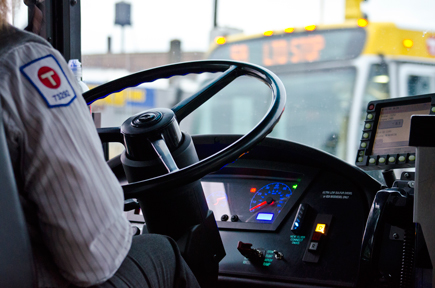As part of a continuing effort to improve efficiency and reduce emissions in transit buses, U of M researchers are conducting a study designed to help Metro Transit select the right bus for the right route.
The research team, led by mechanical engineering professors David Kittelson and Will Northrop, is analyzing and comparing the performance of advanced hybrid buses, standard hybrid buses, and conventional diesel buses on three types of routes.
The advanced hybrid buses, equipped with all-electric accessory systems, were designed for Metro Transit based in part on a previous U of M study that explored how electric-powered accessories could significantly improve fuel efficiency. However, in spite of their benefits, these advanced hybrids may not be the best choice for every route.
“Just like golf clubs, you have to understand what your best application is each time you pull out a tool,” says Brian Lamb, Metro Transit general manager. “Our buses should not be thought of as one-size-fits-all from an application perspective.”
“There are a lot of factors involved in choosing the best bus or optimizing bus specifications,” Kittelson says. “We wanted to look at several types of buses with different degrees of hybridization and electrification and understand the gains we get from these different features.”
The ultimate goal is a modeling tool that considers factors such as route average speed, stops per mile, and climate in order to predict bus performance and emissions. This tool could be used to provide bus specification recommendations for Metro Transit. The study, conducted in collaboration with Metro Transit, was funded by CTS and the U of M’s Institute for Renewable Energy and the Environment.
To evaluate bus performance, the research team collected real-world data on fuel efficiency and emissions from the three types of buses on low-, medium-, and high-speed routes at different times of the year. So far, the team has completed analysis for the advanced hybrid and the conventional diesel buses.
Initial findings indicate that the advanced hybrid has the largest fuel economy and carbon dioxide emissions advantage on low-speed routes that have many starts and stops. In particular, the advanced hybrid bus equipped with start/stop capabilities—which allows the engine to shut down at bus stops and traffic lights—has up to a 60 percent fuel savings.
The researchers also examined nitrogen oxide (NOx) emissions for both types of buses. Although advanced hybrids performed better, emissions were still high in some locations.
Based on these findings, the research team is partnering with the Department of Computer Science to use geospatial mapping to identify NOx hot spots in the Twin Cities. They will also use big data tools to recognize operational and environmental patterns associated with high NOx emissions.
The team is also continuing its work with funding from Cummins, an engine manufacturer, to test emissions on a new 2015 Cummins bus.
According to Lamb, the step-by-step progress being made through this research has already led to large fuel savings for Metro Transit—and agencies across the country. For example, findings from the U’s study on electric-powered accessory systems led to changes that are now used by the entire industry.
“That’s the importance of this research on a practical basis,” Lamb says. “It makes a difference not just from an academic standpoint, but from the livability standpoint of the communities.”




